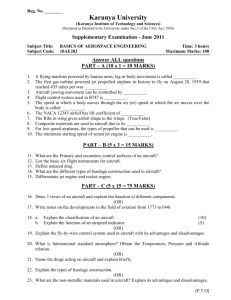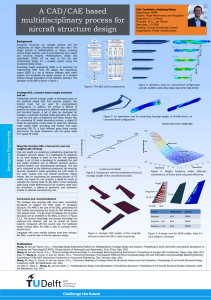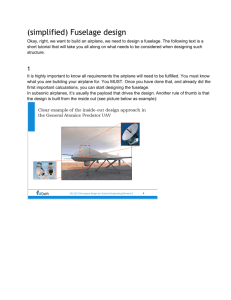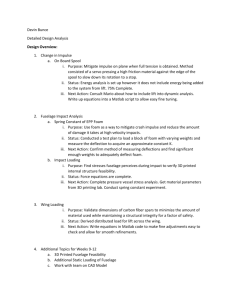Determination Of Fatigue Stress In Aircraft Fuselage
advertisement
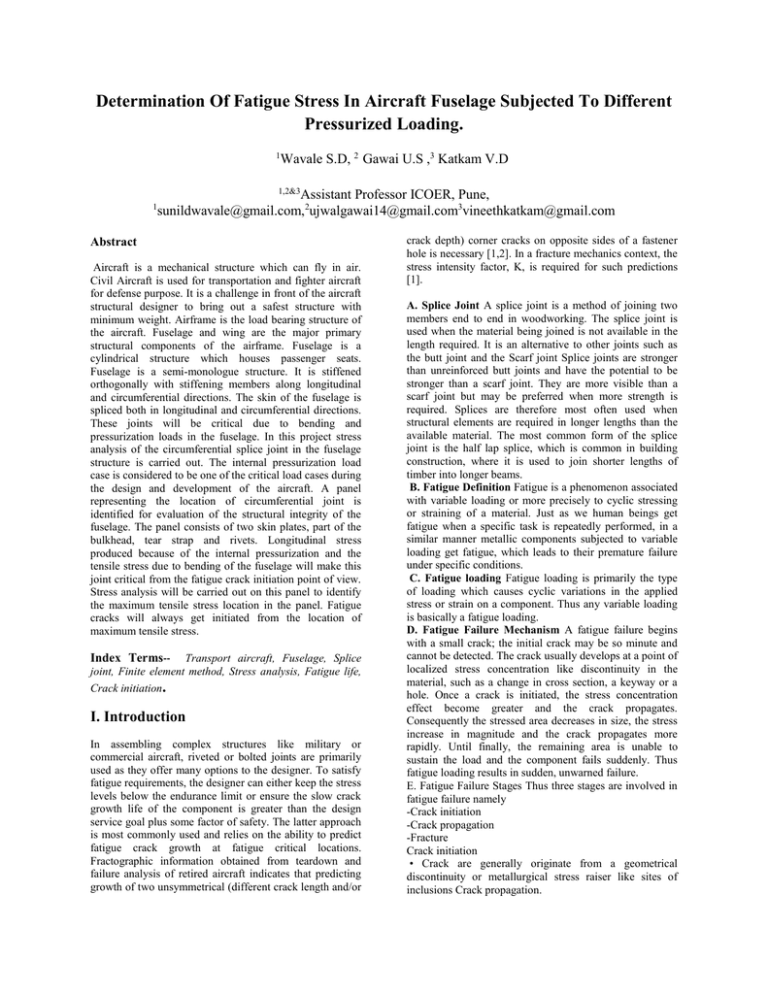
Determination Of Fatigue Stress In Aircraft Fuselage Subjected To Different Pressurized Loading. 1 Wavale S.D, 2 Gawai U.S ,3 Katkam V.D 1,2&3 Assistant Professor ICOER, Pune, sunildwavale@gmail.com,2ujwalgawai14@gmail.com3vineethkatkam@gmail.com 1 Abstract Aircraft is a mechanical structure which can fly in air. Civil Aircraft is used for transportation and fighter aircraft for defense purpose. It is a challenge in front of the aircraft structural designer to bring out a safest structure with minimum weight. Airframe is the load bearing structure of the aircraft. Fuselage and wing are the major primary structural components of the airframe. Fuselage is a cylindrical structure which houses passenger seats. Fuselage is a semi-monologue structure. It is stiffened orthogonally with stiffening members along longitudinal and circumferential directions. The skin of the fuselage is spliced both in longitudinal and circumferential directions. These joints will be critical due to bending and pressurization loads in the fuselage. In this project stress analysis of the circumferential splice joint in the fuselage structure is carried out. The internal pressurization load case is considered to be one of the critical load cases during the design and development of the aircraft. A panel representing the location of circumferential joint is identified for evaluation of the structural integrity of the fuselage. The panel consists of two skin plates, part of the bulkhead, tear strap and rivets. Longitudinal stress produced because of the internal pressurization and the tensile stress due to bending of the fuselage will make this joint critical from the fatigue crack initiation point of view. Stress analysis will be carried out on this panel to identify the maximum tensile stress location in the panel. Fatigue cracks will always get initiated from the location of maximum tensile stress. Index Terms-- Transport aircraft, Fuselage, Splice joint, Finite element method, Stress analysis, Fatigue life, Crack initiation. I. Introduction In assembling complex structures like military or commercial aircraft, riveted or bolted joints are primarily used as they offer many options to the designer. To satisfy fatigue requirements, the designer can either keep the stress levels below the endurance limit or ensure the slow crack growth life of the component is greater than the design service goal plus some factor of safety. The latter approach is most commonly used and relies on the ability to predict fatigue crack growth at fatigue critical locations. Fractographic information obtained from teardown and failure analysis of retired aircraft indicates that predicting growth of two unsymmetrical (different crack length and/or crack depth) corner cracks on opposite sides of a fastener hole is necessary [1,2]. In a fracture mechanics context, the stress intensity factor, K, is required for such predictions [1]. A. Splice Joint A splice joint is a method of joining two members end to end in woodworking. The splice joint is used when the material being joined is not available in the length required. It is an alternative to other joints such as the butt joint and the Scarf joint Splice joints are stronger than unreinforced butt joints and have the potential to be stronger than a scarf joint. They are more visible than a scarf joint but may be preferred when more strength is required. Splices are therefore most often used when structural elements are required in longer lengths than the available material. The most common form of the splice joint is the half lap splice, which is common in building construction, where it is used to join shorter lengths of timber into longer beams. B. Fatigue Definition Fatigue is a phenomenon associated with variable loading or more precisely to cyclic stressing or straining of a material. Just as we human beings get fatigue when a specific task is repeatedly performed, in a similar manner metallic components subjected to variable loading get fatigue, which leads to their premature failure under specific conditions. C. Fatigue loading Fatigue loading is primarily the type of loading which causes cyclic variations in the applied stress or strain on a component. Thus any variable loading is basically a fatigue loading. D. Fatigue Failure Mechanism A fatigue failure begins with a small crack; the initial crack may be so minute and cannot be detected. The crack usually develops at a point of localized stress concentration like discontinuity in the material, such as a change in cross section, a keyway or a hole. Once a crack is initiated, the stress concentration effect become greater and the crack propagates. Consequently the stressed area decreases in size, the stress increase in magnitude and the crack propagates more rapidly. Until finally, the remaining area is unable to sustain the load and the component fails suddenly. Thus fatigue loading results in sudden, unwarned failure. E. Fatigue Failure Stages Thus three stages are involved in fatigue failure namely -Crack initiation -Crack propagation -Fracture Crack initiation • Crack are generally originate from a geometrical discontinuity or metallurgical stress raiser like sites of inclusions Crack propagation. • As a result of the local stress concentrations at these locations, the induced stress goes above the yield strength (in normal ductile materials) and cyclic plastic straining results due to cyclic variations in the stresses. On a macro scale the average value of the induced stress might still be below the yield strength of the material. • This further increases the stress levels and the process continues, propagating the cracks across the grains or along the grain boundaries, slowly increasing the crack size. • As the size of the crack increases the cross sectional area resisting the applied stress decreases and reaches a thresh hold level at which it is insufficient to resist the applied stress. Final fracture: As the area becomes too insufficient to resist the induced stresses any further a sudden fracture results in the component. Results from an experimental and analytical study of a curved stiffened panel subjected to axial compression load are presented. Nonlinear analysis was carried out and validated by the experimental results. Fig 1: geometric configuration of aircraft fuselage. 2. Aircraft Cabin Pressurization. Aircraft are flown at high altitudes for two reasons. First, an aircraft flown at high altitude consumes less fuel for a given airspeed than it does for the same speed at a lower altitude because the aircraft is more efficient at a high altitude. Second, bad weather and turbulence may be avoided by flying in relatively smooth air above the storms. Many modern aircraft are being designed to operate at high altitudes, taking advantage of that environment. In order to fly at higher altitudes, the aircraft must be pressurized. It is important for pilots who fly these aircraft to be familiar with the basic operating principles. In a typical pressurization system, the cabin, flight compartment, and baggage compartments are incorporated into a sealed unit capable of containing air under a pressure higher than outside atmospheric pressure. On aircraft powered by turbine engines, bleed air from the engine compressor section is used to pressurize the cabin. Superchargers may be used on older model turbine-powered aircraft to pump air into the sealed fuselage. Piston-powered aircraft may use air supplied from each engine turbocharger through a sonic venture (flow limiter). Air is released from the fuselage by a device called an outflow valve. By regulating the air exit, the outflow valve allows for a constant inflow of air to the pressurized area [2]. Fig 2: Z sect stiffeners. Fig 3: L section stiffeners. 4. Methodology 3. Geometric Configuration Of The Fuselage: A segment of the fuselage is considered in the current study. The structural components of the fuselage are skin, bulkhead and Stiffeners. Geometric modeling is carried out by using CATIA V16 2012 software. The total length of the structure is 1750mm and diameter is 2200mm. It contains 5nos Z section (Bulkhead) and 40nos L section (Stiffeners). Solution by FEM method Analytical Investigation Solution by FEM method: The project work involves the analysis of the splice joint using software’s MSC/NASTRON & MSC/PATRON. Also, fatigue prediction of splice joint would be carried out. Software’s used 1. MSC/NASTRON & 2.MSC/PATRON A two-dimensional finite element-analysis will be carried out on the splice joint panel. Distribution of fasteners loads and local stress field at rivet locations will be studied from finite element analysis. The work also involves the modifications required to correct the boundary effects of the panel. The global finite element analysis of a segment of typical fuselage will be carried out. This global finite element analysis results will be bench mark for comparing the results from the splice joint panel analysis. Repeated finite element analysis will be carried out to get the response of the parent structure (fuselage) at the joint location. The response of the splice joint will be evaluated through finite element analysis. 5. Results Displacement contour of fuselage structure Fig 6: Stress contour for 6.5 Psi. Fig.4. displacement contour of fuselage 6Psi. Stress contour of fuselage structure structure for Fig 7: Displacement contour for 6.5 Psi. Fig 5: Maximum stress exists in doubler plate for 6Psi. Fig 8:Stress contour for 7 Psi. Table 1: Comparison of FEM and Analytical results 6. Analytical Solution For Analysis. Calculating For Maximum Stress Pr ∆l σmax = , ∈= & σ = E ∗∈ t l Where p = Pressure In Fuselage. r = Radius Of Fuselage. t = Thickness Of Fuselage. W.K.T 1psi = 0.0007kg/mm2 Fuselage Sl. no. Method Displacement (mm) Maximum Stress (MPa) 1 Analytical 1.4437 56.625 2 FEM 1.39 49.23 7. Conclusion In order to improve the aircraft life and make it defect free, stress analysis and fatigue life prediction is carried out on aircraft structure through FEM approach. A FEM approach is followed by the stress analysis of aircraft structure, the internal pressure is one of the main load that the fuselage needs to hold. Stress analysis is carried on structure to identify maximum stress location in the structure. Local analysis is carried out at maximum stress location for fatigue life prediction. 8. References [1] Using The World Largest Stress Intensity Factor Database For Fatigue Life Predictions, Scott A. Fawaz First International Conference on Damage Tolerance of Aircraft Structures R. Benedictus, J. Schijve, R.C. Alderliesten, J.J. Homan (Eds.) [2] Fatigue Damage In Aircraft Structures Not Wanted But Tolerated, Jaap Schijve Delft University of Technology, Faculty of Aerospace Engineering Kluyverweg 1, 2629 HS, The Netherlands First International Conference on Damage Tolerance of Aircraft Structures © TU Delft, The Netherlands. [3] U.G. Goranson, Damage Tolerance, Facts and Fiction. 14th Plantema Memorial Lecture, Proceedings 17th ICAF Symposium, Stockholm, 3-105, 1993. [4] Experimental Technical For Aircraft Fuselage Structures Containing Damage” Padraic E. O’Donoghue, Jinsan Ju Paper presented at the R TO A VT Specialists 'Meeting on "Life Management Techniques for Ageing Air Vehicles held in Manchester, United Kingdom. [5] “New Techniques for Detecting Fatigue Damage Accumlation in Aircraft Structural Components” Curtis A. Rideout Scott J. Ritchie IEEEAC paper #1244, Version 2, November 29, 2006. [6] “Post Buckling Simulation of an Integral Aluminum Fuselage Panel Subjected To Axial Compression Load” Sun Weimin, Tong Mingbo, Guo Liang, and Dong Dengke 2008 Asia Simulation Conference — 7th Intl. Conf. on Sys. Simulation and Scientific Computing.

